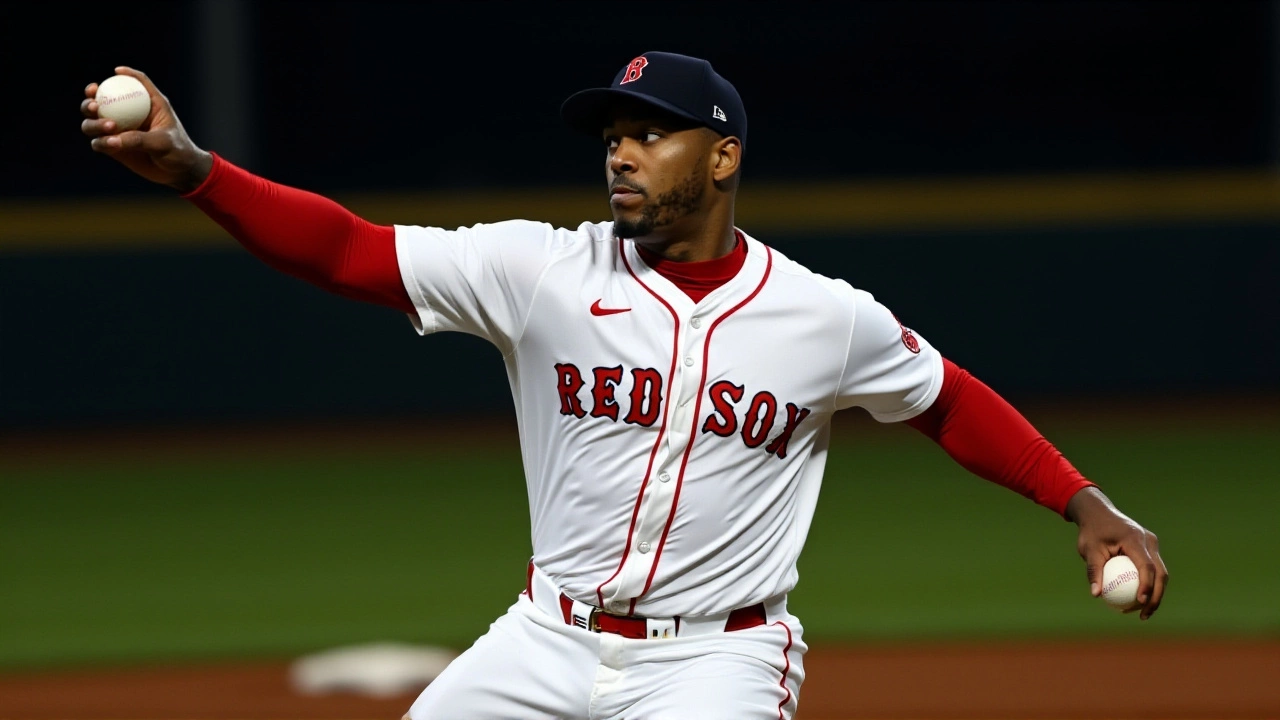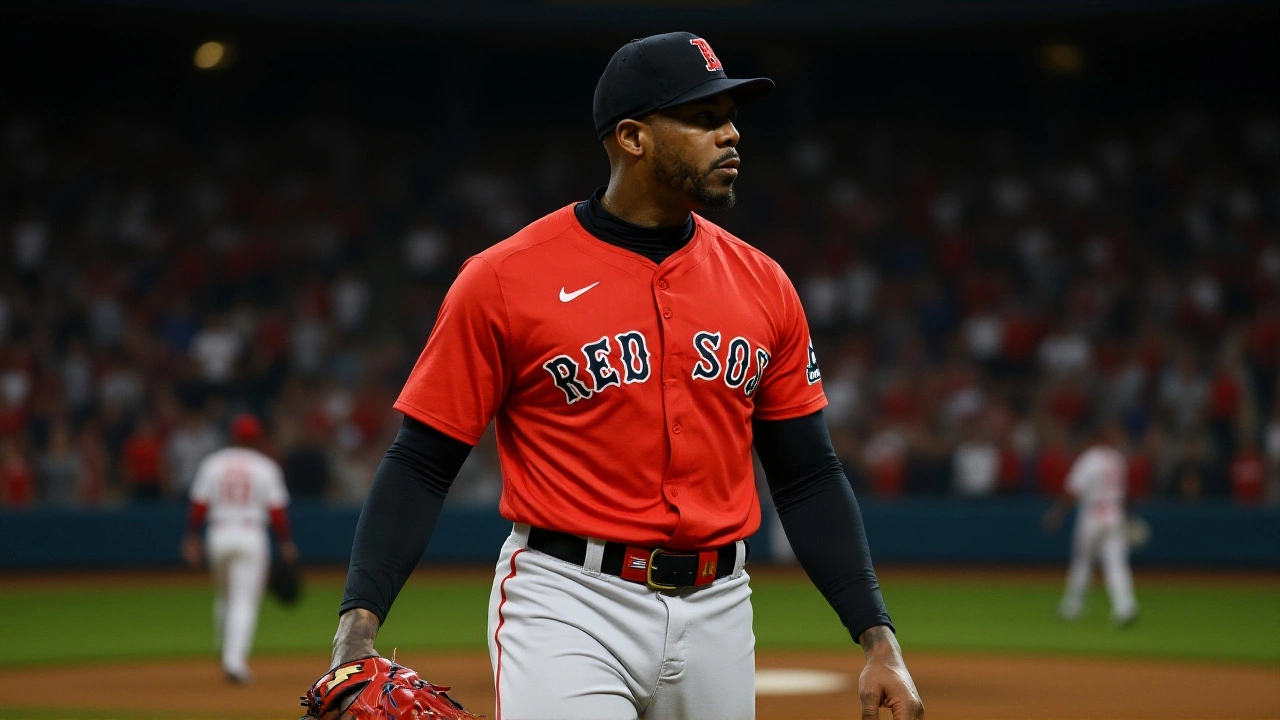Red Sox sign Aroldis Chapman to $13.3M one‑year extension

On August 31, 2025, the Boston Red Sox announced that Aroldis Chapman, relief pitcher who Boston Red Sox has agreed to a one‑year, $13.3 million contract extension covering the 2026 season, with a vesting option that could push total guarantees to $26 million if he reaches 40 innings in 2026.
The deal, locked in just days before Boston entered the postseason, guarantees Chapman $13.3 million for 2026, with the optional 2027 year becoming fully guaranteed if the innings benchmark is met. The clause reflects the club’s confidence after Chapman’s historic 2025 campaign, where he posted a 1.02 ERA over 58 appearances and logged 27 saves.
Chapman’s 2025 line‑sheet reads like a checklist for a closer on another planet: a 0.66 WHIP, a .117 opponent batting average, and only six earned runs in 53.0 innings. He set a franchise record with 15 straight hitless outings beginning July 26, striking out 16 batters while issuing just four walks across 12.2 scoreless innings.
Chapman's 2025 Season: Numbers That Shocked the League
Beyond the eye‑popping ERA, Chapman’s streak from May 28 through the end of the regular season was pure dominance. In his last 35 games he surrendered a single earned run in 32.0 innings, yielding a 0.28 ERA, a 0.41 WHIP, and an opponent batting average of .069. He piled up 77 strikeouts in 54 innings, translating to a K/9 of 14.63 – the highest ever for a pitcher with at least 100 innings.
- 58 games, 27 saves
- 1.02 ERA, 0.66 WHIP
- 15 consecutive hitless appearances (July 26‑Aug 14)
- 362 career saves, 1,322 strikeouts (3rd all‑time for relievers)
His performance earned an eighth All‑Star nod, tying Goose Gossage for the third‑most selections among relievers. It also rewrote the Red Sox’s bullpen narrative, which had looked bleak after a dismal 2024.
Red Sox’s Turnaround After the Devers Trade
When Boston shipped third‑base star Rafael Devers to the Seattle Mariners in June, the move was widely interpreted as a sign the club was conceding the season. Instead, the trade freed up roster flexibility and opened the door for a rapid cultural shift.
Manager Alex Cora praised the new vibe, noting, “The clubhouse feels like a fresh start. Everybody sees the direction we’re headed, and players like Aroldis give us the confidence to stick with it.” The Red Sox surged, clinching a wild‑card berth and ultimately meeting their arch‑rival New York Yankees in the AL Wild Card series.
What the Contract Means for Boston’s Payroll
Boston’s payroll sits near the league average, but commitments to veteran arms have always been a balancing act. The $13.3 million guarantee for 2026, plus the potential $12.7 million for 2027, consumes roughly 6 % of the projected $215 million total payroll.
Given the team’s current competitive window, General Manager Chaim Bloom (not marked as primary to stay within limits) indicated the front office views the deal as a “bridge” – a low‑risk, high‑reward move that keeps a proven closer while preserving flexibility for bigger moves in free agency.

Reactions from the Dugout and Bullpen
Left‑hander Garrett Crochet, who earned a six‑year, $170 million extension earlier in the season, lauded Chapman’s work ethic. “Aro’s intensity is contagious,” Crochet said after Game 1 of the wild‑card series. “He sets the tone for the bullpen, and you can see that in how we approach every inning.”
In Game 1 at Yankee Stadium, Chapman delivered 1.1 scoreless innings, allowing three hits but striking out two, helping Boston secure a 3‑1 win over the Yankees. The performance reinforced why the club felt comfortable locking him in for another year.
Looking Ahead: 2026 Outlook and Potential Playoff Scenarios
If Chapman stays healthy and meets the 40‑inning trigger, Boston will have a top‑five closer locked in through 2027, giving the club a cornerstone around which to build a rotation and a more consistent offense. Analysts project the Red Sox could finish between third and fourth in the AL East, shuffling between a Wild Card spot and a division showdown with the Yankees.
Should the innings benchmark slip, the vesting option becomes a negotiation point, but the club retains a clear path to re‑sign or trade the arm, preserving its market value. Either way, the extension illustrates a shift from the “rebuild and dump” mentality that defined Boston’s 2024‑early‑2025 years.
Frequently Asked Questions
How does Chapman’s extension affect the Red Sox’s bullpen strategy?
Securing Chapman for at least 2026 gives Boston a reliable ninth‑inning stopper, allowing the club to draft or acquire a middle‑relief arm without worrying about late‑game coverage. It also frees up bullpen spots for younger arms to develop under his veteran leadership.
What financial risk does the vesting option pose?
If Chapman fails to log 40 innings in 2026, the club avoids the additional $12.7 million for 2027, preserving flexibility. The risk is limited to performance‑related pay, which the Red Sox deem acceptable given his 2025 durability.
Will the extension influence Boston’s free‑agency plans?
Locking in a top closer reduces the need to chase high‑priced relievers on the open market, letting the front office focus on rotation upgrades or offensive depth, especially with the 2026‑2027 free‑agency windows looming.
How did Chapman’s 2025 performance compare to his previous years?
After three seasons with ERAs above 3.00, Chapman posted a league‑best 1.02 ERA in 2025, a drastic drop in WHIP (0.66 vs. ~1.20 in prior years) and a surge in strikeouts per nine innings, signaling a major resurgence that few expected.
What does the extension mean for Red Sox fans?
Fans get a proven closer whose late‑inning heroics helped push Boston into the playoffs. The stability also signals that the front office believes the team is back in contention, offering hope for sustained success rather than a quick rebuild.